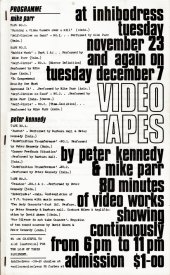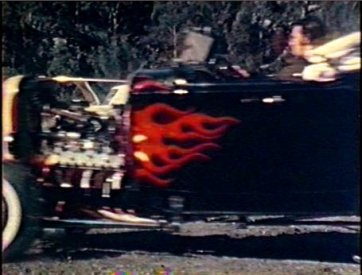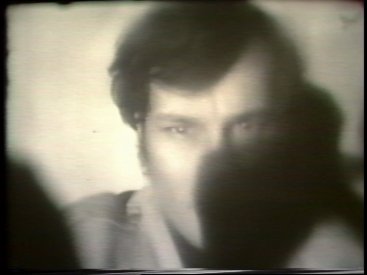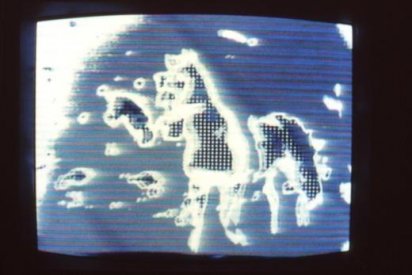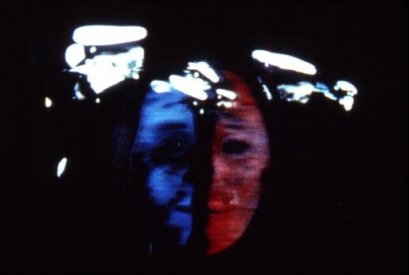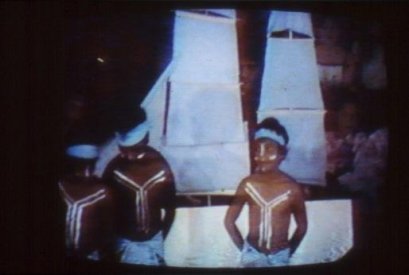Peter Kennedy was born in Brisbane in 1945 and began painting in his teenage years. He had his first show at the Johnstone Gallery in 1964, and then moved to Sydney later that year with the intention of studying at East Sydney Tech (now the National Art School). In 1965 he showed in the Young Contemporaries exhibition at Farmers Blaxland Gallery, in Sydney, and at the Museum of Modern Art and Design Australia, Melbourne.
Crucially, it was the library at East Sydney Tech that reset Kennedy’s path. There he first came across international art magazines such as Art Forum and Studio International, the latter of which embraced a multitude of new ways of making and exhibiting art with articles ranging from arte povera and outsider art to recent kinetic art, systems art and other electronic forms such as computer art.1 It was through these magazines, bringing news of the avant garde from Europe and the USA, that he first came across the screen prints and performance work of Robert Rauschenberg, the mechanical processes of language and abstraction demonstrated by Jasper Johns, and the many other international artists who were exploring pathways out from the hegemony of expressionism and geometric abstraction. Such artists in the US and Europe had begun the experimentation that led to both the conceptual turn in object-making and the object’s subsequent dematerialisation, and to experimentation with directly technological forms of art making, such as computer art and video art.
In the late 1960s, the leading American art critic Clement Greenberg promoted notions of quality, art for art’s sake, and the eschewing of novelty as being the only basis for judging the value of art in the culture, arguing his position strongly in his 1968 Power Lecture, Avant Garde Attitudes.2 His support for an art market based on scarcity and the exclusion of non-traditional art forms through the selling of “quality” was recognised as being a highly political position, and was not universally accepted overseas or in Australia (a considerable degree of criticism of this view was stirring). When Donald Brook gave his Power lecture Flight from the Object in 19693 — his rejoinder to Greenberg’s position — he articulated a new way of thinking that had already gained local adherents (and thereby demonstrated the importance of the international art magazines).
While Kinetic art was an area in which light, movement and new materials featured, and by 1968 was being assiduously collected by the Power Institute, Brook’s position liberated many artists and opened up a condition in which they could now feel free to explore the wealth of new ideas arriving from Britain, Eastern Europe, Italy and the United States, as well as those being originated here. These included art that was in some manner driven by electricity, light art and video art being among those with which Kennedy began to work.
Kennedy was among the earliest to embrace this shift in thinking. In a 2010 interview4 Kennedy said that he read of the collaborative performance activities of Rauschenberg, John Cage and Merce Cunningham at Black Mountain College, and their work within the frame of Experiments in Art and Technology5 around 1966. Other international artists whose work drew his interest were Dan Flavin, Keith Sonnier, and the Greek-American luminist Chryssa, all of whom worked with light during the 1960s.
These intellectual encounters led Kennedy to realise that he might work towards a rupture in the then standard conventions of art in Australia:
… this stuff that I encountered in 1965 [and after] was clear evidence for possibilities for breaking away from those conventions. And I thought about this for a long time, not knowing quite what to do with it and I guess it was in the late 60s and most particularly in 1969 that I thought that the opportunity was emerging for me to actually strike out into some new territory.6
It took him until about 1969 to discover how he might do this, however, but given an already strong interest in colour, that potential for experiment led him to making art with light. It also introduced him to film and video as artistic media, to body art and performance, and subsequently to become involved in the Inhibodress project — although it was the work of the light artists that initially drew his interest. Due to economic circumstance he took a job at Claude Neon in Sydney designing neon lights for their commercial clients. He presented two solo exhibitions of light works at Gallery A Sydney in 1970 (Neon Light Installations) and 1971 (Luminal Sequences)7 which demonstrated the view that, as Frank Popper remarked in 1967, light art is “an art which acts on and transforms the environment”,8 and which Jenepher Duncan, in Luminaries (1993), her historical overview for the Monash University re-collection of light art, spoke of as “activat[ing] the space around it”.9
In August 1970 Mike Parr called a meeting of artists who might be interested in establishing an artist-run space in which to develop and exhibit work that broke the boundaries of the traditional and might be considered experimental. Fifteen artists joined together, agreeing to share the rent of a space at Charles St, Woolloomooloo, and the radical experimental “post-painterly notion of art as a process”10 that was Inhibodress began.11 Kennedy’s income from Claude Neon not only assisted his production of the light works but also allowed him to contribute to the maintenance of Inhibodress, and particularly its international program:
“that I got up and running in late 1970 or early 1971 ... And out of that program I collected stuff from overseas and made several exhibitions that went on at Inhibodress. I guess in late 1971, but most particularly 1972.”12
The mainstays of Inhibodress were Kennedy, Parr and Tim Johnson. Inhibodress was a site of experiment into a variety of forms of post-object (to use Donald Brook’s term) or conceptual art. Johnson produced a series of socially provocative works13, Parr extended his pre-poems14 and both Kennedy and Parr began a program of performance works, many of which were recorded to video and subsequently film.
Kennedy’s Luminal Sequences was one of a pair of shows that demonstrated what Kennedy thought of as Interference Variables, and was installed in two ‘phases’ at both Gallery A and Inhibodress in March 1971. Barbara Hall in her press release for the two wrote: “The idea behind both Phase One and Phase Two is creative and aesthetic use of interference which is normally considered a destructive force.”15 The Gallery A phase of this work was Luminal Sequences and consisted in the installation of a multiplicity of light sources including fluorescents, neons, theatre lights and slide projections throughout the gallery. Many of these were on timers and flicked on and off at apparently random intervals so that the general lighting of the gallery changed from moment to moment.
The Inhibodress phase of the pair was the performance installation But the Fierce Blackman, which was a sound installation with media that “react[s]to participants.”16 It has become among Kennedy’s most renowned works from the period. Several pieces of contemporary entertainment technologies were installed along the centre line of the gallery. These were a TV set tuned to an empty channel which picked up noise interspersed with random taxi calls, a tape recorder playing an amplified and heavily cut-up tape loop (in the manner of Steve Reich’s Come Out) of the phrase “but the fierce black man”, a microphone which allowed audience participation and by which Kennedy inserted a loud statement of the phrase into the mix every 30 minutes. The TV antenna, a pair of ‘rabbit ears’ was hit randomly by wires hung from the ceiling and blown against it by a large fan so that the behaviour of the TV reception changed constantly. The TV also provided the only light in the room and, all in all it was a “mass of noise”. This was Kennedy’s first and certainly one of the earliest Australian uses of a TV set in an artwork.
The Inhibodress trio were already aware of the use of video17 in its enabling various kinds of screen-based interactions (and social feedbacks) between the artists and the context, such as through mediating the artist’s performance to the audience, as well as in documenting performance works. In mid 1971, they arranged to make a series of videotape recordings (to Akai ¼” black and white videotape) of performances they devised. These works, recorded at Inhibodress, are both subjective (particularly the Parr works) and structural (particularly the Kennedy works), and Kennedy’s works were also drawn from his interest in electronic sound.
The videotapes were then shown at Inhibodress as Video Tapes by Peter Kennedy and Mike Parr on two evenings in late November and early December 1971. The quality of the playback wasn’t up to what the artists wanted so they tried to remake the works on ½” Sony open reel videotape, but this also did not produce good results. So they invited Aggy Read and Ian Stocks (late of Ubu Films) to assist them in filming a revised set of the performances which became the film Idea Demonstrations.
Over 1973–74 (after Inhibodress had closed in 1972), Kennedy went overseas and continued to develop his interest in a more political, activist class of work. He filmed a series of interviews with artists such as Adrian Piper and Hans Haacke in the US, and Ian Breakwell or Steve Willats in the UK, among others who were making socially committed works. This became the film Other Than Art’s Sake, in which he intended to demonstrate
“that there was another kind of art practice option, shall we say, which in the Northern Hemisphere — at least in America — was occurring outside of art galleries and was addressing non-art audiences in one way or another, in an attempt to make an art that arose from criteria other than those that we would bring to bear on what we would conceive as being the traditional or conservative point of view constituting a work of art.”18
On his return he produced Introductions, a videotape presentation and installation (at Central Street Gallery in Sydney, and at the National Gallery of Victoria in Melbourne, both in 1976) in which he worked with non-art recreational groups. The work consisted in the productions and documentation of an experiment in social engagement, not dissimilar to the work of British systems artist Steve Willats19. In constructing the work, Kennedy spent a good deal of time with four more-or-less suburban recreational groups: a Hot Rod Club, the Embroiderers Guild, a Bushwalking Club, and a Marching Girls Club. He introduces the members of each group to the others, in the hope
“that each may relate to the other and enjoy insights to the other through the sharing of a common experience … [consisting of] each group’s relationship to the project as a whole, and by implication their relationship to me, the person who has worked with each group in constructing representations of group activities or concerns.”20
These representations included:
-
videotapes made by members of each group on “those aspects of club behaviour and social perceptions which the members specified as being most important”;
-
watercolour paintings by Kennedy that functioned as group portraits; and
-
a film in which “club members are seen as visitors to the exhibition, as well as in various external locations relevant to”21 each group’s activities.
The overall intention was that the members of the recreational groups should participate in the actual construction of the work as exhibition.22
Kennedy’s interest in the political functions of video continued and he made November 11, shown at the 1979 Biennale of Sydney,23 and a second stage, November 11 — installation no. 2, shown at the 1981 Australian Perspecta,24 both made in collaboration with the Melbourne filmmaker John Hughes. The videos locate the national political events of 1975 — specifically, the sacking of the Whitlam government — within an historical context. The original installation of November 11 (1979) consisted of an oil painted banner in the manner of a late 19th century Trade Union banner in front of which the video tape was displayed on a TV monitor.
“The synthesis of an historically and culturally important form of expression as the trade union banners [with] video, the modern means of mass communication constitutes a method of integrating traditional and modern media that has been characteristic of the work produced in the last five or six years.”25
November 11 part 2 and a further work in the series, On Sacred Land (1983–84), also take the form of the installation of November 11 part 1, consisting of a large banner (or history painting in On Sacred Land) with the videotape displayed on a TV monitor in front of the banner.
Kennedy continues to use video in his installation works, as mentioned in the series of notes about the actual works.
- 1. In 1968, Studio International became the catalogue for Cybernetic Serendipity, at that time an extraordinary, radical adventure into all sorts of new art forms that involved the use of electricity, among these being computer images and video. See Cybernetic Serendipity: the computer and the arts, Jasia Reichardt, Studio International, London, 1968. Catalogue of the exhibition held at the Institute of Contemporary Art, Nash House, The Mall, London, 2 August – 20 October 1968.
- 2. Flight From the Object: the Power Lecture 1969, Donald Brook, Power Institute of Contemporary Art, University of Sydney, 1970.
- 3. Flight From the Object: the Power Lecture 1969, Donald Brook, Power Institute of Contemporary Art, University of Sydney, 1970.
- 4. Peter Kennedy: interview with Stephen Jones, recorded 16 September 2010.
- 5. See 9 evenings: theatre & engineering, Billy J. Klüver, et al, the catalogue for the event at the Armory in New York, October 1966; and 9 evenings reconsidered: art, theatre and engineering, 1966, Catherine Morris (curator), MIT List Visual Arts Center, Cambridge, Mass., 2006.
- 6. Peter Kennedy: interview with Stephen Jones, recorded 11 September 2005.
- 7. “Imagining Gallery A Sydney: Peter Kennedy interviewed.”, Nicholas Chambers, in John Murphy (curator), Gallery A, Sydney, 1964–1983, Campbelltown Arts Centre and Newcastle Region Art Galleries, March 2009, Campbelltown, exhibition catalogue.
- 8. “The Luminous Trend in Kinetic Art”, Frank Popper, Studio International, Vol. 173, No. 886, Feb 1967, p. 75.
- 9. Luminaries, eds Jenepher Duncan and Zara Stanhope, Monash University Gallery, 3 September – 23 October 1993, p. 15. Catalogue to the exhibition at the Monash University Gallery, Clayton. Curator: Jenepher Duncan. Assistant Curator: Natalie King.
- 10. “Second Floor Utopians”, Donald Brook, Sydney Morning Herald, 12 November 1970, p. 12.
- 11. Sue Cramer, Inhibodress 1970–1972, Institute of Modern Art, Brisbane, 1989.
- 12. Peter Kennedy: interview with Stephen Jones, recorded 11 September 2005.
- 13. For example, his Disclosures series.
- 14. With works such as 150 Programs and Investigations, and Wall Definitions.
- 15. Barbara Hall: press release for the two phases of Interference Variables, March 1971.
- 16. Ibid.
- 17. Peter Kennedy: interview by Stephen Jones, recorded 11 September 2005.
- 18. Peter Kennedy: interview by Stephen Jones, recorded 11 September 2005.
- 19. Kennedy had interviewed Willats in 1974 for his film Other than Art’s Sake.
- 20. Peter Kennedy, in Two Contemporary Artists, Jennifer Phipps, The Trustees of the National Gallery of Victoria, Melbourne, 1976. Exhibition catalogue.
- 21. Ibid.
- 22. Introductions was purchased for the NGV Australian Art department in 1977.
- 23. European Dialogue: The Third Biennale of Sydney, Nick Waterlow (curator), Biennale of Sydney, AGNSW, Sydney, 1979. Catalogue of the exhibition held at the AGNSW, 14 April – 27 May 1979.
- 24. Australian Perspecta 1981, Bernice Murphy (curator), AGNSW, Sydney, 1981. Catalogue of the exhibition, a biennial survey of contemporary Australian art, held at the AGNSW, 28 May – 21 June 1981.
- 25. Peter Kennedy, in European Dialogue: The Third Biennale of Sydney, Nick Waterlow (curator) and Kerry Crowley (ed.), Biennale of Sydney, AGNSW, Sydney. Catalogue of the exhibition held at the AGNSW, 14 April – 27 May 1979.
